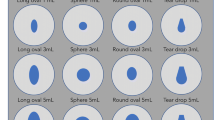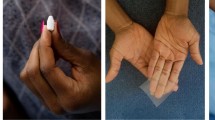Abstract
Research has demonstrated that certain vaginal gel products—microbicides containing antiretroviral drugs—may reduce HIV infection risk among women. But for vaginal gels to avert HIV and other sexually transmitted infections (STIs), at-risk women must be willing to use them as directed. These products must therefore be “acceptable” to women and an important component of acceptability is users’ perception that the product will work to prevent infection. We sought to understand how women’s perceptions of vaginal gel properties may shape their understanding of product efficacy for HIV and STI prevention. Sixteen women completed two in-depth qualitative interviews (k = 32) to identify the range and types of sensory perceptions they experienced when using two vaginal gels. We identified emergent themes and linkages between users’ sensory perceptions and their beliefs about product efficacy. Users’ predictions about product efficacy for preventing infection corresponded to measurable physical properties, including gel volume, location in the vagina, coating behavior, sensation of the gel in the vagina, leakage, and gel changes during coital acts. Although the women described similar sensory experiences (e.g., gel leaked from the vagina), they interpreted these experiences to have varying implications for product efficacy (e.g., leakage was predicted to increase or decrease efficacy). To improve microbicide acceptability, gel developers should investigate and deliberately incorporate properties that influence users’ perceptions of efficacy. When a microbicide is approved for use, providers should educate users to anticipate and understand their sensory experiences; improving users’ experience can maximize adherence and product effectiveness.
Similar content being viewed by others
References
Abdool Karim, Q., Abdool Karim, S. S., Frohlich, J. A., Grobler, A. C., Baxter, C., Mansoor, L. E., … Taylor, D. (2010). Effectiveness and safety of tenofovir gel, an antiretroviral microbicide, for the prevention of HIV infection in women. Science, 329, 1168–1174.
Anton, P., Cranston, R., Carballo-Dieguez, A., Kashuba, A., Khanukhova, E., Elliott, J., … McGowan, I. (2011). RMP-02/MTN-006: A phase 1, placebo-controlled trial of rectally applied 1% vaginal Tenofovir gel with comparison to oral Tenofovir Disoproxil Fumarate. Paper presented at the conference on Retroviruses and Opportunistic Infections, Boston, MA.
Bass, E. (2002). IAVI report—Learning from microbicides: A young field’s experience working with high-risk women. AIDScience, 2(17). Retrieved from http://aidscience.org/Articles/iavi007.asp.
Dezzutti, C. S., Rohan, L. C., Wang, L., Uranker, K., Shetler, C., Cost, M., … Friend, D. (2012). Reformulated tenofovir gel for use as a dual compartment microbicide. Journal of Antimicrobial Chemotherapy, 67, 2139–2142.
Greene, E., Batona, G., Hallad, J., Johnson, S., Neema, S., & Tolley, E. E. (2010). Acceptability and adherence of a candidate microbicide gel among high-risk women in Africa and India. Culture, Health, & Sexuality, 12, 739–754.
Guest, G., Johnson, L., Burke, H., Rain-Taljaard, R., Severy, L., von Mollendorf, C., & Van Damme, L. (2007). Changes in sexual behavior during a safety and feasibility trial of a microbicide/diaphragm combination: An integrated qualitative and quantitative analysis. AIDS Education and Prevention, 19, 310–320.
Holmes, W. R., Maher, L., & Rosenthal, S. L. (2008). Attitudes of men in an Australian male tolerance study towards microbicide use. Sexual Health, 5, 273–278.
MacGowan, I. (2010). Microbicides for HIV prevention: Reality or hope? Current Opinion in Infectious Diseases, 26, 26–31.
Mantell, J. E., Dworkin, S. L., Exner, T. M., Hoffman, S., Smit, J. A., & Susserd, I. (2006a). The promises and limitations of female-initiated methods of HIV/STI protection. Social Science and Medicine, 63, 1998–2009.
Mantell, J. E., Morar, N. S., Myer, L., & Ramjee, G. (2006b). “We have our protector”: Misperceptions of protection against HIV among participants in a microbicide efficacy trial. American Journal of Public Health, 96, 1073–1077.
Mantell, J. E., Myer, L., Carballo-Dieguez, A., Stein, Z., Ramjee, G., Morar, N. S., & Harrison, P. F. (2005). Microbicide acceptability research: Current approaches and future directions. Social Science and Medicine, 60, 319–330.
Marrazzo, J., Ramjee, G., Nair, G., Palanee, T., Mkhize, B., Nakabiito, C., … VOICE Study Team. (2012). Pre-exposure prophylaxis for HIV in women: Daily oral Tenofovir, oral Tenofovir/Emtricitabine, or vaginal Tenofovir gel in the VOICE Study (MTN 003). Paper presented at the Conference on retroviruses and opportunistic infections.
Morrow, K. M., Fava, J. L., Rosen, R. K., Christensen, A. L., Vargas, S., & Barroso, C. (2007a). Willingness to use microbicides varies by race/ethnicity, experience with prevention products, and partner type. Health Psychology, 26, 777–786.
Morrow, K. M., Fava, J. L., Rosen, R. K., Vargas, S., Barroso, C., Christensen, A. L., … Severy, L. (2007b). Willingness to use microbicides is affected by the importance of product characteristics, use parameters, and protective properties. Journal of Acquired Immune Deficiency Syndromes, 45, 93–101.
Morrow, K. M., Fava, J. L., Rosen, R. K., Vargas, S., Shaw, J. G., Kojic, E. M., … The Project LINK Study Team. (2013). Designing preclinical perceptibility measures to evaluate topical vaginal gel formulations: Relating user sensory perceptions and experiences to formulation properties. AIDS Research and Human Retroviruses. doi:10.1089/aid.2013.0099.
Morrow, K., Rosen, R., Vargas, S., Barroso, C., Kiser, P., & Katz, D. (2010, May). User-identified vaginal gel characteristics: A qualitative exploration of perceived product efficacy. Paper presented at the International Microbicides Conference, Pittsburgh, PA.
Morrow, K. M., & Ruiz, M. S. (2008). Assessing microbicide acceptability: A comprehensive and integrated approach. AIDS and Behavior, 12, 272–283.
Padian, N. S., Buve, A., Balkus, J., Serwadda, D., & Cates, W. J. (2008). Biomedical interventions to prevent HIV infection: Evidence, challenges, and way forward. Lancet, 372, 585–599.
Ritchie, J., & Lewis, J. (Eds.). (2003). Qualitative research practice: A guide for social science students and practitioners. London: Sage.
Rotheram-Borus, M. J., Swendeman, D., & Chovnick, G. (2009). The past, present, and future of HIV prevention: Integrating behavioral, biomedical, and structural intervention strategies for the next generation of HIV prevention. Annual Review of Clinical Psychology, 5, 143–167.
Saethre, E. J., & Stadler, J. (2010). Gelling medical knowledge: Innovative pharmaceuticals, experience, and perceptions of efficacy. Anthropology & Medicine, 17, 99–111.
Short, M. B., Mills, L., Majkowski, J. M., Stanberry, L. R., & Rosenthal, S. L. (2003). Topical microbicide use by adolescent girls: Concerns about timing, efficacy, and safety. Sexually Transmitted Diseases, 30, 854–858.
Short, M. B., Succop, P. A., Ugueto, A. M., & Rosenthal, S. L. (2007). Predictors of using a microbicide-like product among adolescent girls. Journal of Adolescent Health, 41, 357–362.
Smith, J., & Firth, J. (2011). Qualitative data analysis: The framework approach. Nurse Researcher, 18, 52–62.
Thurman, A. R., Clark, M. R., & Doncel, G. F. (2011). Multipurpose prevention technologies: Biomedical tools to prevent HIV-1, HSV-2, and unintended pregnancies. Infectious Diseases in Obstetrics and Gynecology. doi:10.1155/2011/429403.
Verguet, S., & Walsh, J. A. (2010). Vaginal microbicides save money: A model of cost-effectiveness in South Africa and the USA. Sexually Transmitted Infections, 86, 212–216.
Vickerman, P., Watts, C., Delany, S., Alary, M., Rees, H., & Heise, L. (2006). The importance of context: Model projections on how microbicide impact could be affected by the underlying epidemiologic and behavioral situation in 2 African settings. Sexually Transmitted Diseases, 33, 397–405.
Watts, C., & Vickerman, P. (2001). The impact of microbicides on HIV and STD transmission: Model projections. AIDS, 15, S43–S44.
Acknowledgments
This study was funded by the National Institutes of Health: R21/R33 MH080591 (Morrow, PI) and by USAID through a contract with CONRAD (PPA-09-023/USAID GPO-A-00-08-00005-00). Portions of the data presented here were presented at the International Microbicides Conference 2010, Pittsburgh, PA. The authors would like to extend their appreciation to Candelaria Barroso (now at the Division of Immunology, The Miriam Hospital, Providence, RI) and Liz Salomon (Fenway Community Health Center; now The Fenway Institute, Boston, MA) for their efforts in implementing Project LINK, Stage 1. We would also like to acknowledge HTI Plastics (www.HTIPlastic.com) and Rip n Roll, Inc. (www.RipnRoll.com) for their donations of study supplies, and to Open Enterprises, Inc. (www.goodvibrations.com), for providing discounts on study supplies. Most respectfully, we would like to gratefully acknowledge the time and commitment of the Project LINK participants, without whom the important work begun in Project LINK would not have been accomplished.
Author information
Authors and Affiliations
Corresponding author
Rights and permissions
About this article
Cite this article
Morrow, K.M., Underhill, K., van den Berg, J.J. et al. User-Identified Gel Characteristics: A Qualitative Exploration of Perceived Product Efficacy of Topical Vaginal Microbicides. Arch Sex Behav 43, 1459–1467 (2014). https://doi.org/10.1007/s10508-013-0235-5
Received:
Revised:
Accepted:
Published:
Issue Date:
DOI: https://doi.org/10.1007/s10508-013-0235-5




